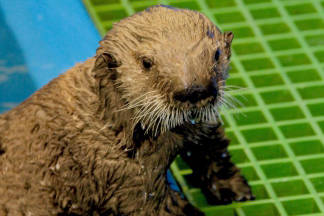Dixon the male sea otter pup is continuing his recovery at the Alaska SeaLife Center two months after he was found in Homer — dehydrated, malnourished and barely responsive.
The sea otter, named after Dixon Glacier, has gone through extensive treatment since he was admitted to the SeaLife Center on Aug. 9 with bacterial infections, anemia and severe intestinal issues, according to a release from the SeaLife Center.
“The prognosis for this otter looked grave,” said Veterinarian Kathy Woodie. “But he had a fighting spirit and overcame tremendous health conditions.”
Since his admittance, Dixon has nearly doubled in size, from 8 pounds to more than 15 pounds. He is fed a special formula in addition to small pieces of clam, capelin and squid.
“Now that he has overcome many medical hurdles and has cleared quarantine we are working to integrate him with other otters at our facility,” said Lisa Hartman, husbandry director at the SeaLife Center. “At four months old, Ranney, our female otter, is of similar age and size to Dixon and is hopefully his first companion.”
Sea otters are a keystone species for Alaska’s marine ecosystem, playing a vital role in plant health and local fish populations. Stranding events, like Dixon’s, are unfortunate but allow the SeaLife Center to identify issues negatively affecting Alaska’s sea otters, according to the SeaLife Center.

